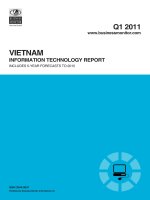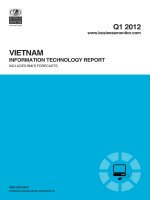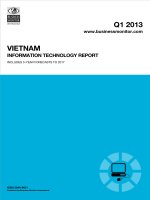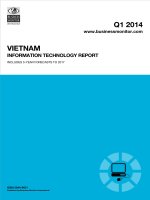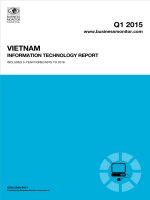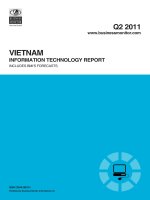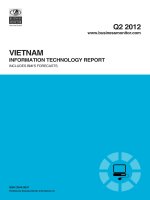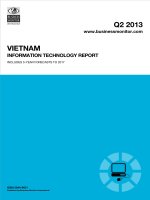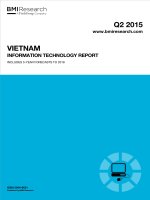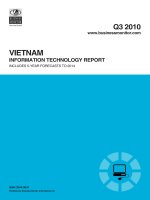Vietnam information technology report q3 2010
Bạn đang xem bản rút gọn của tài liệu. Xem và tải ngay bản đầy đủ của tài liệu tại đây (362.05 KB, 48 trang )
Q3 2010
Published by Business Monitor International Ltd.
www.businessmonitor.com
INFORMATION TECHNOLOGY REPORT
ISSN 2044-9631
Published by Business Monitor International Ltd.
VIETNAM
INCLUDES 5-YEAR FORECASTS TO 2014
Business Monitor International
Mermaid House,
2 Puddle Dock,
London, EC4V 3DS,
UK
Tel: +44 (0) 20 7248 0468
Fax: +44 (0) 20 7248 0467
Email:
Web:
© 2010 Business Monitor International.
All rights reserved.
All information contained in this publication is
copyrighted in the name of Business Monitor
International, and as such no part of this publication
may be reproduced, repackaged, redistributed, resold in
whole or in any part, or used in any form or by any
means graphic, electronic or mechanical, including
photocopying, recording, taping, or by information
storage or retrieval, or by any other means, without the
express written consent of the publisher.
DISCLAIMER
All information contained in this publication has been researched and compiled from sources believed to be accurate and reliable at the time of
publishing. However, in view of the natural scope for human and/or mechanical error, either at source or during production, Business Monitor
International accepts no liability whatsoever for any loss or damage resulting from errors, inaccuracies or omissions affecting any part of the
publication. All information is provided without warranty, and Business Monitor International makes no representation of warranty of any kind as
to the accuracy or completeness of any information hereto contained.
VIETNAM
INFORMATION
TECHNOLOGY REPORT
Q3 2010
INCLUDES 5-YEAR FORECASTS TO 2014
Part of BMI’s Industry Report & Forecasts Series
Published by: Business Monitor International
Publication date: June 2010
Vietnam Information Technology Report Q3, 2010
© Business Monitor International Ltd Page 2
Vietnam Information Technology Report Q3, 2010
© Business Monitor International Ltd Page 3
CONTENTS
Executive Summary 5
SWOT Analysis 8
Vietnam IT Sector SWOT 8
Vietnam Telecoms SWOT 9
Vietnam Political SWOT 10
Vietnam Economic SWOT 11
Vietnam Business Environment SWOT 12
Vietnam Market Overview 13
Hardware 14
Software 16
Services 18
Industry Developments 19
Industry Forecast Scenario 23
Table: Vietnam IT Sector (US$mn Unless Otherwise Stated) 25
Internet 26
Table: Telecoms Sector – Internet – Historical Data And Forecasts 26
Macroeconomic Forecast 28
Table: Vietnam – Economic Activity 30
Competitive Landscape 31
Hardware 31
Software 32
IT Services 35
Internet 36
Company Profiles 38
FPT Software 38
Country Snapshot: Vietnam Demographic Data 39
Section 1: Population: 39
Table: Demographic Indicators 39
Table: Rural/Urban Breakdown 40
Section 2: Education & Healthcare 40
Table: Education 40
Table: Healthcare: Vital Statistics 40
Section 3: Labour Market And Spending Power 41
Table: Employment Indicators 41
Table: Consumer Expenditure 41
BMI Methodology 43
How We Generate Our Industry Forecasts 43
IT Industry 43
IT Ratings – Methodology 44
Table: IT Business Environment Indicators 45
Vietnam Information Technology Report Q3, 2010
© Business Monitor International Ltd Page 4
Weighting 46
Table: Weighting Of Components 46
Sources 46
Vietnam Information Technology Report Q3, 2010
© Business Monitor International Ltd Page 5
Executive Summary
Market Overview
The Vietnamese IT market is estimated to grow at a compound annual growth rate (CAGR) of 9% over
the 2010-2014 period. Consumer retail spending recorded growth in 2009 despite the economic
slowdown, in part due to tariff reductions and aggressive price cutting. Government and business IT
spending took a hit, but is expected to pick up in 2010.
The overall Vietnam IT market outlook for 2010 is one of a broad recovery that gathers pace in the
second half of the year. PC sales were slower than expected during the Lunar New Year peak shopping
season in Q110, partly because steep price discounting in 2009 had weakened the attraction to consumers
of traditional seasonal discounts.
The addressable domestic market for IT products and services is projected by to reach US$2.9bn by 2014.
An ambitious IT plan for 2010-2020 should shape many segments of the Vietnamese IT market, while
Vietnam’s improving information and communication technology (ICT) infrastructure will also drive
growth. Vietnam’s gradual integration into global trade networks such as the Association of Southeast
Asian Nations (ASEAN) and the WTO has helped to bring down prices and increase opportunities for
importers.
Industry Developments
The government’s Strategy for IT Development covers the 2010-2020 period and focuses on four major
areas: enhancing IT application, developing the local IT industry, developing ICT infrastructure and
developing IT human resources. A number of specific IT plans have been developed including one to
modernise IT in government agencies, which was approved in March 2009. In an April 2010 cabinet
meeting, Prime Minister Nguyen Tan Dung ordered all members of his cabinet to use computers while
working.
In January 2010, the Vietnam Post and Telecoms Group (VNPT) in Ho Chi Minh City launched a local
version of the Computers for Education programme, which will provide teachers and students in the city
with low-priced laptops and DSL broadband connections. The discounts will be available through
VNPT’s 30 retail outlets and 200 agents in the city. In August 2009, the Ministry of Education and
Training launched a national programme to supply 1mn affordable computers to Vietnamese schools by
2011.
Import taxes on electronic products and components were lowered from January 2009, in accordance with
the government’s commitments under the ASEAN free trade area (AFTA), which Vietnam entered in
2006. As of January 2009, duty on complete build unit electronic products from ASEAN countries was
reduced to 0-5%. Eligible products must have an ASEAN content of at least 40%. Meanwhile, the China-
Vietnam Information Technology Report Q3, 2010
© Business Monitor International Ltd Page 6
ASEAN free trade agreement offers both opportunities and challenges to vendors, especially given the
growing presence of low-cost Chinese vendors in the Vietnamese market.
Competitive Landscape
Multinational brands dominate the Vietnamese PC market, with HP the top-selling PC brand in 2009,
ahead of Acer. HP’s sales have been boosted by government and education sector projects, as well as by
its strategy to target the consumer segment. Other multinational PC vendors including Dell, Toshiba and
Asus have enjoyed strong recent growth in the booming market.
Vietnamese software producers have a greater presence in their domestic market. Local products
accounted for around 75% of market value in 2008 while foreign vendors have around 25%. Local
companies have a particularly strong position in the government and small and medium-sized enterprise
(SME) segments, while larger Vietnamese corporations are more likely to consider more expensive
software from multinationals.
Vietnam has around 10,000 firms currently licensed to provide IT services, but only one-third are actually
operating. The Ministry of Information and Communications is currently developing a draft decree to
map out policies to help the IT industry grow and this is due by the end of the year. The decree will
stipulate procedures and operational requirements for firms providing IT services.
Computer Sales
BMI projects that sales in Vietnam’s computer hardware market will be worth around US$1.3bn in 2010,
up from an estimated US$1.2bn in 2009. The main growth driver will be affordable notebooks, with
various models of the smaller form factor netbooks selling well in 2009.
PC penetration in Vietnam was around 9.6% in 2007, according to World Bank figures, and in 2010 is
estimated by BMI at around 15%. Notebooks are owned by an estimated 7% of the Vietnamese
population. This points to significant growth potential for the local PC market, with the most potential
being in rural areas. Currently Hanoi and Ho Chi Minh City are thought to account for in the region of
85% of notebook sales.
Software
In 2010, Vietnamese software sales are projected by BMI to grow to US$178mn, despite the uncertain
economic conditions, and software CAGR for 2010-2014 should be in the region of 12%. Software
spending comprises around 10% of total Vietnamese IT spending.
Vietnam Information Technology Report Q3, 2010
© Business Monitor International Ltd Page 7
The market is expected to reach a value of around US$312mn by 2014, with steady growth in demand for
licensed software from government, enterprise and household segments. However, some vendors and
distributors saw a slowdown in 2009 due to global economic headwinds. Vietnam’s software market is
developing, despite the problem of software piracy, which still accounts for around 85% of software,
compared with 76% in neighbor Thailand.
Services
Vietnamese IT services spending is forecast to reach around US$343mn in 2010, up from US$297mn in
2009. The economic crisis had an impact in 2009, with projects being put on hold. However, sectoral
CAGR is projected at 11% over the forecast period, as the market approaches US$588mn by 2014.
IT services now accounts for around 18% of total Vietnam IT spending. Over the past few years, the size
of IT services deals has increased in key IT spending verticals. Growing demand for digital infrastructure
projects in segments such as banking, telecoms, energy and government has attracted global IT services
providers to invest more in Vietnam.
E-Readiness
Vietnam’s fixed-line infrastructure is unreliable and offers poor coverage. However, Vietnam has an
exceptionally high penetration rate in the mobile market, reaching 126% at the end of 2009, and
registering around 110.8mn subscribers. This has been aided by mobile network operators reducing tariffs
to encourage growth of their respective subscriber bases, as well as increased investment in the expansion
of infrastructure to areas outside major towns and cities. Demand for mobile broadband has also been
accelerated by the changing lifestyles of consumers, who use the service for accessing the internet for
work and leisure.
Vietnam Information Technology Report Q3, 2010
© Business Monitor International Ltd Page 8
SWOT Analysis
Vietnam IT Sector SWOT
Strengths
! The domestic IT market is in a rapid growth phase, with trade liberalisation and
growing affordability driving projected double-digit growth of notebook computers.
! 2010-2014 CAGR of 9% forecast as per capita IT spend reaches US$31 by 2014,
from US$21 in 2009.
! Expanding ICT infrastructure and internet penetration will continue to drive demand
for IT products and services.
! Vietnam’s gradual integration into the global trade network via its accession into
trade organisations such as ASEAN and WTO as well as bilateral agreements with
Japan and China.
Weaknesses
! IT spend per capita much lower than in neighbour Thailand, reflecting a much
lower GDP and GDP per capita.
! Low levels of access to credit and budgets restrain spending by SMEs.
! Highly cost-sensitive market, with 75% of software provided by lower-cost local
software vendors.
! High level of software piracy at 85%, although it has fallen in the last few years.
Opportunities
! High PC market growth potential particular in rural areas due to overall low PC
penetration rate of 15%.
! Vast and relatively under-penetrated rural market presents a significant growth
opportunity as the government rolls out measures to boost rural connectivity and
incomes.
! National IT Plan will drive spending on IT utilisation in areas like e-government, e-
taxation and education.
! SMEs have much potential to increase spending on basic solutions, including
customer relationship management and security.
! One Teacher-One Computer programme aims to deliver 1mn computers to
schools by 2011.
! The banking and finance sector is a promising area for database software and one
where foreign companies have done well.
! Banking and finance, oil and gas, aviation and telecoms are projected to be some
of the biggest opportunities for multinational vendors.
! Tax agencies at all levels of administration are looking to increase the efficiency of
tax collection.
! The government’s drive to create a significant IT services industry over the next
15-20 years is expected to be a significant factor shaping the IT market.
Threats
! Continued depreciation of the dong against the US dollar would increase the
pressure on Vietnamese distributors of foreign IT goods.
! Falling prices may further undermine margins and profitability after steep
discounting in 2009.
The implementation of the China-ASEAN free trade agreement means that
established multinationals will face a growing challenge from low-cost Chinese
vendors in the Vietnamese market.
Vietnam Information Technology Report Q3, 2010
© Business Monitor International Ltd Page 9
Vietnam Telecoms SWOT
Strengths
! Fixed-line penetration levels and internet user rates are high in major urban centres
such as Ho Chi Minh City, Hanoi, Danang and Haiphong.
! Competition exists in fixed-line and internet access markets; VNPT faces competition
from several other state-owned companies and two privately-owned operators.
! High levels of literacy and other demographic factors bode well for strong and
continued demand for wireline services over the next few years.
Weaknesses
! Vietnam’s fixed-line and internet access markets are both dominated by state-
controlled operators, VNPT and Viettel.
! Although alternative broadband infrastructures are currently being explored,
broadband growth continues to be dependent on DSL.
! Low fixed-line penetration rates in rural regions limit the scope for DSL broadband
growth.
! Internet user growth is slowing, despite the limited access to internet infrastructure in
much of rural Vietnam.
! Broadband tariffs remain high, creating a barrier for low-income subscribers to
access.
Opportunities
! The privatisation of VNPT could help to bring about increased investment revenues
and the arrival of new skills.
! On a national level, broadband penetration rates remain low; this means that the
sector has considerable growth potential.
! VNPT plans to invest US$1bn in 2009, in order to upgrade its broadband networks
and expand its international internet bandwidth.
! Significant opportunities exist to develop alternative broadband technologies,
including WiMAX and fibre.
! WiMAX services are currently being trialled with a view to licensing a number of
WiMAX service providers in the near future; WiMAX internet services have the
potential to raise the level of internet user penetration in rural parts of Vietnam.
! Draft Bill of Law on Telecommunication has been put forward for discussion at the
National Assembly Steering Committee. If passed, the bill will allow private
companies to build network infrastructure for the first time and will open up the
telecoms market to foreign investors.
Threats
! Fixed-line sector may enter a period of decline, with potentially negative
consequences for ADSL growth.
! As the market for mobile data services grows, this could have potentially negative
consequences for the growth of fixed broadband services.
! Slower economic growth in 2009 and 2010 could undermine wireline investment and
expansion plans.
Vietnam Information Technology Report Q3, 2010
© Business Monitor International Ltd Page 10
Vietnam Political SWOT
Strengths
! The Communist Party government appears committed to market-oriented
reforms, although specific economic policies will undoubtedly be discussed at
the 2011 national congress. The one-party system is generally conducive to
short-term political stability.
! Relations with the US are generally improving and Washington sees Hanoi as a
potential geopolitical ally in South East Asia.
Weaknesses
! Corruption among government officials poses a major threat to the legitimacy of
the ruling Communist Party.
! There is increasing (albeit still limited) public dissatisfaction with the leadership’s
tight control over political dissent.
Opportunities
! The government recognises the threat that corruption poses to its legitimacy
and has acted to clamp down on graft among party officials.
! Vietnam has allowed legislators to become more vocal in criticising government
policies. This is opening up opportunities for more checks and balances within
the one-party system.
Threats
! The slowdown in growth in 2009 and 2010 is likely to weigh on public
acceptance of the one-party system, and street demonstrations to protest
economic conditions could develop into a full-on challenge of undemocratic rule.
! Although strong domestic control will ensure little change to Vietnam’s political
scene in the next few years, over the longer term, the one-party-state will
probably be unsustainable.
! Relations with China have deteriorated over the past year due to Beijing’s more
assertive stance over disputed islands in the South China Sea and domestic
criticism of a large Chinese investment into a bauxite mining project in the
central highlands, which could potentially cause wide-scale environmental
damage.
Vietnam Information Technology Report Q3, 2010
© Business Monitor International Ltd Page 11
Vietnam Economic SWOT
Strengths
! Vietnam has been one of the fastest-growing economies in Asia in recent years,
with GDP growth averaging 7.6% annually between 2000 and 2007.
! The economic boom has lifted many Vietnamese out of poverty, with the official
poverty rate in the country falling from 58% in 1993 to 20% in 2004.
Weaknesses
! Vietnam still suffers from substantial trade, current account and fiscal deficits,
leaving the economy vulnerable as the global economy continues to suffer in
2010. The fiscal picture is clouded by considerable ‘off the books’ spending.
! The heavily managed and weak currency, the dong, reduces incentives to
improve quality of exports and also serves to keep import costs high, thus
contributing to inflationary pressures.
Opportunities
! WTO membership has given Vietnam access to both foreign markets and
capital, while making Vietnamese enterprises stronger through increased
competition.
! The government will, in spite of the current macroeconomic woes, continue to
move forward with market reforms, including privatisation of state-owned
enterprises and liberalising the banking sector.
! Urbanisation will continue to be a long-term growth driver. The UN forecasts the
urban population to rise from 29% of the population to more than 50% by the
early 2040s.
Threats
! Inflation and deficit concerns have caused some investors to re-assess their
hitherto upbeat view of Vietnam. If the government focuses too much on
stimulating growth and fails to root out inflationary pressure, it risks prolonging
macroeconomic instability, which could lead to a potential crisis.
! Prolonged macroeconomic instability could prompt the authorities to put reforms
on hold, as they struggle to stabilise the economy.
Vietnam Information Technology Report Q3, 2010
© Business Monitor International Ltd Page 12
Vietnam Business Environment SWOT
Strengths
! Vietnam has a large, skilled and low-cost workforce that has made the country
attractive to foreign investors.
! Vietnam’s location – its proximity to China and South East Asia as well as its
good sea links – makes it a good base for foreign companies to export to the
rest of Asia, and beyond.
Weaknesses
! Vietnam’s infrastructure is still weak. Roads, railways and ports are inadequate
to cope with the country’s economic growth and links with the outside world.
! Vietnam remains one of the world’s most corrupt countries. Its score in
Transparency International’s 2009 Corruption Perceptions Index was 2.7,
placing it in 22
nd
place in the Asia Pacific and 120
th
worldwide.
Opportunities
! Vietnam is increasingly attracting investment from key Asian economies, such
as Japan, South Korea and Taiwan. This offers the possibility of the transfer of
high-tech skills and knowhow.
! Vietnam is pressing ahead with the privatisation of state-owned enterprises and
the liberalisation of the banking sector. This should offer foreign investors new
entry points.
Threats
! Ongoing trade disputes with the US and the general threat of American
protectionism, which will remain a concern.
! Labour unrest remains a lingering threat. A failure by the authorities to boost
skills levels could leave Vietnam a second-rate economy for an indefinite period.
Vietnam Information Technology Report Q3, 2010
© Business Monitor International Ltd Page 13
Vietnam Market Overview
Government Authority
The Ministry of Information and Communications (MIC) is the main Vietnamese policymaking and
regulatory body in the fields of IT, although its brief also covers a number of other areas such as
telecommunications, broadcasting and publishing.
The MIC’s major functions include proposing and drafting laws, regulations and development plans
related to IT and other policy areas. The current national framework for IT is the Strategy for IT
Development, which was approved in 2005 and covers the 2010-2020 period.
Background
The Vietnamese IT market – including computer hardware, packaged software and IT services – was
valued at US$1.7bn in 2009. Vietnam IT spend per capita, at around US$19 in 2009, is considerably
lower than the US$178 estimated for ASEAN neighbour Thailand. However, IT spend per capita is
expected to grow to US$31 by 2014.
Computer hardware, including desktops, notebooks, and accessories, is the largest IT market segment in
Vietnam, accounting for around 73% of spending in 2009. Packaged software was valued at US$155mn
that year, equivalent to around 9% of spending. IT services and outsourcing comprised 18% of spending.
Tariff reform, expanding internet infrastructure, a growing economy and government programmes will all
play a part in driving Vietnamese IT market growth over our five-year forecast period. Vietnam has a
relatively good IT and telecommunications infrastructure, with particularly high mobile telecoms
penetration. However, with PC penetration at just 15%, there is still a large portion of the population that
do not participate in the digital society and are unable to afford the latest IT products.
The household sector, which accounts for only around 10% of the IT market currently, should increase its
share by 2014. The country’s vast, under-penetrated rural market offers the most PC market growth
potential, with Hanoi and Ho Chi Minh City accounting for most sales currently, also presents a
significant growth opportunity as the government rolls out measures to boost rural incomes.
The government sector is a key segment of the Vietnamese IT market and comprises about 30% of
national IT spending. Public IT spending by around 7,000 government organisations at national,
provincial and municipal levels will provide important opportunities to vendors. A number of
Government Authority Ministry of Information and Communications (MIC)
Minister Le Doan Hop
Vietnam Information Technology Report Q3, 2010
© Business Monitor International Ltd Page 14
programmes exist to increase IT utilisation in areas like e-government, e-taxation and education. The
national IT plan has regional components, focused on northern, eastern and southern regions.
The private sector accounts for around 60% of IT demand and both domestic and foreign enterprises are
investing in IT to boost performance. Large corporations are more likely to buy software from top-tier
vendors, but SMEs account for the majority of Vietnam’s 400,000 enterprises and are increasingly a
target for multinationals. There is a lot of potential for Vietnamese enterprises of all sizes to increase
spending on basic solutions, including customer relationship management (CRM) and security.
The Vietnamese IT market remains constrained by high levels of grey market activity, and particularly by
software piracy, which accounts for around 85% of installed software. However, the rate has come down
from 95% in the last two years due to a more proactive government approach to the problem.
ICT Sector
The ICT sector is a key growth priority for the Vietnamese government, which has a plan to grow it.
Currently, the IT industry is relatively small and accounts for just 0.5% of the country’s GDP, according
to government figures. IT industry revenues in 2009 were estimated at US$6.2bn, up 20% on 2008.
Vietnam has around 150 software companies, many of which are focused on export markets.
The government has set an ambitious target of 14% annual growth for the ICT sector, with total turnover
to reach US$50bn by 2014. US$14bn is to come from hardware and US$5bn from software.
Telecommunications is projected to account for half the total, or US$25bn.
Hardware
BMI projects that sales in Vietnam’s computer hardware market will be worth around US$1.3bn in 2010,
up from an estimated US$1.2bn in 2009. The main growth driver will be affordable notebooks, with
various models of the smaller form factor netbooks selling well in 2009.
PC penetration in Vietnam was around 9.6% in 2007, according to World Bank figures, and in 2010 is
estimated by BMI at around 15%. Notebooks are owned by an estimated 7% of the Vietnamese
population, which points to significant growth potential for the local PC market, with the most potential
being in rural areas. Currently, Hanoi and Ho Chi Minh City are thought to account for around 85% of
notebook sales.
In the first quarter of 2010, notebook sales were slower than expected. The relatively sluggish sales were
attributed in part to price cuts in 2009. These meant that traditional Lunar New Year holiday season price
discounting had less appeal to consumers than previously.
Vietnam Information Technology Report Q3, 2010
© Business Monitor International Ltd Page 15
In 2009, imports received a boost following cuts in import tariffs on finished electronic products. Despite
the effects of the global economic crisis, the long-term fundamentals should support strong growth. Sales
of PCs are expected to pick up later in 2010 as new vendors enter the market while others roll out new
models.
Growth in 2009 was being driven by the consumer segment, with government and business spending
having slowed due to the effects of the economic crisis. In contrast, Vietnamese retail sales posted an
impressive 21.5% year-on-year (y-o-y) growth in January-April 2009, with local consumers apparently
more optimistic than their peers in many other Asian economies.
The spread of fixed and mobile broadband services will spur purchases of mobile PCs as connectivity
devices. As elsewhere, telecoms operators such as Viettel are emerging as significant distribution
channels for notebooks as vendors seek tie-ups. Going forward, government programmes are expected to
make a significant contribution to computer sales. In August 2009, the Vietnamese government
announced a national programme to supply 1mn computers at favourable prices to Vietnamese schools by
2011. Multinational IT vendors such as Acer, Intel and Microsoft were all participating in the
programme. Desktops will retail under the programme at around US$161, or about half the usual price.
The computers will come loaded with educational software and with broadband connections.
The programme received reinforcement with the launch in Ho Chi Minh City in January 2010 of a
programme entitled One Teacher-One Computer. The programme, which has support from the VNPT and
the Ministry of Education and Training, will provide laptops at a price that is VND800,000 below the
market price. Discounts of up to 80% for schools and 30% for teachers will also be offered on VNPT’s
broadband service packages. Laptop prices were expected to fall by 10-15% in 2009, boosting sales. In
H109, the effects of recent cuts in duty were apparent in electronics retail stores, with leading brands of
notebooks selling at notable discounts to their 2008 prices. In 2008, value added tax (VAT) on electronic
products was raised from 5% to 10%, but that hike has now been reversed and much of the benefits
seemed to have been passed on to consumers. At local electronics and home appliance retail centres,
prices for popular notebooks models by vendors such as HP, Sony and Dell had been reduced by 7-12%.
The PC market had slowed to about 8% growth in 2008, with high interest and inflation rates and
currency instability meaning that consumers and SMEs cut back on spending to save money. However,
sales showed some signs of recovery in H208 and growth is expected to be about 18% in 2009.
In H208, vendors turned the situation around with promotions for the back-to-school period and new
models that were launched to capitalise on the traditionally higher demand in the second half of the year.
The biggest threat to continued growth was inflation, which peaked at around 27% in 2008 and made
computer products less affordable. An easing of inflation should see sales growth pick up again.
Vietnam Information Technology Report Q3, 2010
© Business Monitor International Ltd Page 16
The main driver of sales is notebooks, for which the addressable market was estimated at around 700,000
units in 2009. Vendors and retailers reported double-digit growth for notebooks in the first half of 2009.
Notebooks were responsible for around 30% of PC sales, but should pass 50% within the forecast period.
In particular, LCD-screen notebooks are forecast to grow at an almost triple-digit rate over the next year.
Vendors are promoting small form factor netbooks, a segment that achieved triple-digit growth in 2008.
However, this segment will face strong competition from low-end notebooks with more features.
Software
In 2010, Vietnam software sales are projected by BMI to grow to US$178mn, despite the uncertain
economic conditions, and software CAGR for 2010-2014 should be in the region of 12%. Software
spending comprises around 10% of total Vietnamese IT spending.
The market is expected to reach a value of around US$312mn by 2014, with steady growth in demand for
licensed software from government, enterprise and household segments. However, some vendors and
distributors saw a slowdown in 2009 due to global economic headwinds.
Vietnam’s software market is developing, despite the problem of software piracy, which still accounts for
around 85% of software, compared with around 76% in neighbouring Thailand. While high, the 85% rate
represents a drop from 95% in 2007, as the government has gradually implemented a stricter regulatory
framework. As usual, the problem is more one of enforcement rather than a lack of legal provisions. In
the past year, the government has appeared to take a more active stance towards enforcement of copyright
regulations. Decree 47.2007.NP-CP, which became effective in June 2009, allows for a penalty of up to
VND500mn (around US$28,000) for instances of software piracy. In April 2010, it was announced that
Bach Khoa Internet Security Centre (or BKIS) and Lac Viet Computer Joint Stock Co had become
the first Vietnamese firms to join the Business Software Alliance, a global software industry association
that focuses on copyright issues.
The Vietnamese software market remains highly cost-sensitive, with around 75% of the market served by
lower-cost local software vendors. Local software dominates the market for government and SME
segments. However, larger Vietnamese companies are more likely to buy higher-priced software from
multinationals, which have around 25% of the market. Vietnamese customers are demanding a higher
level of support for software compared with a few years before.
Growing PC penetration, as well as new technologies and business models including 3G mobile and
WiMAX, and industry trends such as software-as-a-service (SaaS) and open source will provide areas of
Vietnamese software market growth going forward. Most demand remains for on-premises subscription
models, due to the greater perceived security and degree of control. However, as internet infrastructure
improves in Vietnam, there should be more demand for alternative models such as SaaS and cloud
computing.
Vietnam Information Technology Report Q3, 2010
© Business Monitor International Ltd Page 17
In 2010, sales of Microsoft’s new Windows 7 operating system should have a positive impact on software
revenues, although much will depend on consumer and business confidence. Microsoft officially
introduced Windows 7 in Vietnam in early November 2009, with the programme being installed in PCs
sold at leading electronics distributors such as Nguyen Kim, Tran Anh, Phong Vu and Dang Khoa.
Microsoft will introduce a Vietnamese version of Windows Live and has announced a list of Vietnamese
software programmes that are compatible with Windows 7 including Vietnamese font programmes,
dictionaries and accounts software. There should also be a boost from systems upgrades delayed from
2009.
The economic downturn may have added to the forces driving interest in open-source software due to its
perceived lower cost and access to codes. The economic downturn has led businesses and customers to
look more closely at open-office-type open-source software, as well as free services such as Google Docs,
which are funded by advertising. Once again, a key issue and precondition for the more widespread
adoption of open source will be the development of a support infrastructure.
There is still a lot of potential for Vietnamese enterprises to increase spending on basic solutions,
including CRM and security. Over BMI’s five-year forecast period, the Vietnamese enterprise software
market should offer opportunities in many sectors. While management software remains at less than 10%
of the total software market, basic applications such as enterprise resource planning (ERP) and accounting
are finding increasing popularity with the business market. There is a growing emphasis on cost
efficiency as enterprises look to enhance productivity through automating these and other functions.
The economic slowdown, and fall in demand for manufactured goods, represented a challenge for
vendors as enterprises were tempted to focus more on the bottom line. Many companies, particularly
trading companies, cut back on non-essential systems upgrades in the face of cash-flow shortages.
Smaller enterprises will be a growth opportunity due to growing awareness. Companies are looking for
software that will help boost performance and operational efficiency. Promising segments include discrete
manufacturing, consumer packaged goods and hotels and property management.
Security software such as anti-virus and internet security applications is one segment that should grow in
line with increased awareness among Vietnamese organisations of the benefits. Vendors should also look
to areas such as CRM and business intelligence, where faster growth is possible, due to untapped
potential in key segments such as CRM, ERP and human resource management (HR). Data analytics and
database software is likely to be a growing area and account for a larger portion of software budgets. The
banking and finance sector is a promising area for database software and one where foreign companies
have done well.
The internet service provider (ISP) sector is a promising segment for software and services vendors, as a
government campaign to boost internet usage is set to cause an increase in the number of ISPs. To date,
Vietnam Information Technology Report Q3, 2010
© Business Monitor International Ltd Page 18
only 17 ISPs have been licensed. ISPs are also expected to move towards offering more IT services and
hosted software themselves. Web analytics is one promising area, as firms look to assess the effectiveness
of their online presence and advertising in more detail.
Government is a significant software-purchasing segment in Vietnam and accounts for about 30% of total
IT spending. The 7,000 government agencies offer considerable opportunities at national provincial and
municipal levels. A particular area of opportunity is tax agencies of all administrative tiers as
governments look to increase the efficiency of tax collection. Meanwhile, the Vietnamese government’s
drive to implement e-government will be another driver in this segment.
Banking and finance, oil and gas, aviation and telecoms are forecast to be some of the biggest spending
software segments over BMI’s five-year forecast horizon and among the best opportunities for foreign
vendors. These segments offer the most potential for customised solutions as well as off-the-shelf
packaged software. Spending opportunities in the finance segment will be driven by regulatory
compliance, due to regulations such as Basel II, HIPPA and the Sarbanes-Oxley Act, as well as potential
new regulations introduced in the wake of the global financial crisis. Mobile operators are investing in
new OSS (operating support systems) to reduce costs and support delivery of new services.
Services
Vietnamese IT services spending is forecast to reach around US$343mn in 2010, up from US$297mn in
2009. The economic crisis had an impact in 2009, with projects being put on hold. However, sectoral
CAGR is projected at 11% over the forecast period, as the market approaches US$588mn by 2014.
IT services now account for around 18% of total Vietnamese IT spending. Over the past few years, the
size of IT services deals has increased in key IT spending verticals. Growing demand for digital
infrastructure projects in segments such as banking, telecoms, energy and government has attracted global
IT services giants such as IBM to invest more in Vietnam. Large local organisations such as the
Corporation for Financing and Promoting Technology (FPT) have also targeted this opportunity and
announced plans to compete with established multinational vendors and offer high-quality outsourcing
services.
Vietnam suffers from a shortage of trained IT workers, however, with some estimating that Vietnam
would need an additional 1mn IT engineers in order to achieve the government’s ambitious targets for the
domestic software and IT services sector. Lack of language skills and patchy ICT infrastructure are other
barriers, and this situation represent an opportunity for external service providers and trainers.
The MIC said in early 2010 that it would draft a decree to regulate operational requirements and
procedures for firms providing IT services, and pointed to a lack of regulations currently for businesses
providing IT services, consulting or security services. The draft decree is to focus on mapping out policies
Vietnam Information Technology Report Q3, 2010
© Business Monitor International Ltd Page 19
to help the IT industry grow in the future and is due by the end of 2010. Significantly for vendors,
however, the decree is also to suggest measures to boost the usage of IT services in state-owned bodies.
Measures to gradually eliminate firms that had been previously licensed to provide IT services but were
for whatever reason not actually doing so will be included in the decree. According to the ministry,
Vietnam has around 10,000 firms currently licensed to provide IT services. However, only one-third are
operating.
The three major IT services categories currently are be hardware deployment, hardware support and
systems integration (SI). Much IT services work remains add-ons to hardware deployments, with local
resellers of IT vendors such as Dell, HP and Oracle offering support and implementation.
Although the provision of IT services is still typically built around hardware sales, the consulting element
has been growing, along with a focus on return on investment. Enterprises increasingly seek external
advice in prescribing an IT strategy, particularly for informatisation, networking and identifying vendors.
ERP systems are a key focus and security is also a fast-growing area, with SI expanding into security
consulting, implementation, support and training services, which require high expertise in networks and
anti-virus applications.
Meanwhile, outsourcing is a future growth area due to improving ICT infrastructure and international
bandwidth as well as government targets for growth of the domestic IT services and software sector. The
government’s drive to create a significant IT services industry in Vietnam over the next 15-20 years is
expected to be a significant factor shaping this opportunity. Vietnam hopes to leverage its competitive
prices to claim a larger share of the global outsourcing market. According to market research firm
Gartner, the number of companies embarking on outsourcing negotiations last year had increased to
36%, up 10% over the previous year.
More investment in local call centres will generate spending on IT hardware, software and services and be
another source of opportunities for IT vendors. In 2010, Japanese company Moshi Moshi established
MOCAP Vietnam Joint Stock Company, in partnership with a Vietnamese company, to provide call
centre services for the Vietnamese market. MOCAP Vietnam was claimed to be the first outsourcing
company established with Japanese backing in Vietnam. However, economic growth and rising spending
power should attract new entrants to this segment going forward.
Industry Developments
Government IT Strategy
The government’s IT policies are governed by a Strategy for IT Development approved in 2005. The plan
covers the 2010-2020 period and focuses on four major areas: enhancing IT application, developing the
local IT industry, developing ICT infrastructure and developing IT HR. Key opportunities for IT vendors
Vietnam Information Technology Report Q3, 2010
© Business Monitor International Ltd Page 20
involve the development utilisation of IT applications. Major threads here include building and
developing e-citizens, building e-government and e-business, as well as developing transactions and e-
commerce.
A number of specific IT plans have been developed, including one to modernise IT in government
agencies, which was approved in March 2009. In an April 2010 cabinet meeting, Prime Minister Nguyen
Tan Dung ordered all members of his cabinet to use computers while working. New government
departments continue to go online in 2010, with the Ministry of Agriculture and Rural Development
launching its e-portal in February 2010.
Other government ICT projects include a plan to modernise the customs department in 2050-2010 and a
Tax Administration Modernisation Plan for the 2008-2013 period. Other plans include developing the
internet in rural communities (2008-2013) and developing the Vietnamese IT industry. The plans all have
regional versions, focused on the central, south and northern regions.
Government PC Programmes
Vietnam’s government ICT programmes are expected to boost PC sales. In August 2009, the Ministry of
Education and Training launched a national programme to supply 1mn affordable computers to
Vietnamese schools by 2011. The computers will come loaded with educational software and broadband
connections. Multinational vendors Acer, Intel and Microsoft were participating in the programme. The
desktops will sell for around US$161 – about half the normal price.
In January 2010, VNPT in Ho Chi Minh City launched a local version of the programme that will provide
teachers and students in the city with low-priced laptops and DSL broadband connections. The discounts
will be available through VNPT’s 30 retail outlets and 200 agents in the city.
Meanwhile, the roll-out of e-government infrastructure and services should also be a driver of PC sales
during BMI’s forecast period. In September 2009, the government launched an e-procurement pilot
system. The system will be used by the Hanoi People’s Committee, the Electricity Group of Vietnam
and the Telecommunications Post Group in the initial trail phase from 2009-2011. In the second phase,
for 2011-2015, the system will be gradually expanded to all public agencies and state-owned enterprises
across all economic sectors.
Lower Import Tariffs
Import taxes on electronic products and components were lowered from January 2009, in accordance with
the government’s commitments under the AFTA, which Vietnam entered in 2006. As of January 2009,
duty on complete build unit (CBU) electronic products from ASEAN countries was reduced to 0-5%.
Eligible products must have an ASEAN content of at least 40%. Meanwhile, the average import tax on
components was reduced from 9.41% to 6.36%.
Vietnam Information Technology Report Q3, 2010
© Business Monitor International Ltd Page 21
Vietnam’s admission into the WTO in January 2007 provided additional momentum for market
liberalisation. As Vietnam implements its WTO commitments, more than 300 IT products will enjoy a
zero tariff in three to seven year’s time, compared with previous tariffs of 2-8%. Meanwhile, another
development set to reduce tariffs on some high-end electronic products was the Vietnam-Japan economic
partnership agreement, which came into effect at the beginning of 2009. Under the agreement, import
taxes on electronics goods imported directly from Japan have been reduced by 2.5-4.5%. The lower tariffs
for AV products such as TV sets, laptops and cameras will be in force in five to 10 years, with the tax
reductions gradually being lowered year by year. Impact is likely to be limited as only around 1% of
Japanese electronics products sold on the Vietnamese market are directly imported from Japan. The
majority are imported from Thailand, Malaysia and Singapore.
The China-ASEAN free trade agreement offers both opportunities and challenges to vendors, especially
given the growing presence of low-cost Chinese vendors in the Vietnamese market.
Impact On Local Manufacturing
The tariff reductions are likely to have a significant effect on the development of the local market and
Vietnam’s electronics industry. Foreign manufactures have already signalled their intentions to roll back
or cease their assembly operations in Vietnam and to rely on imports from neighbouring ASEAN
countries. Meanwhile, due to a lack of a large-scale parts and components industry in Vietnam, it is very
difficult for local producers to compete on price with foreign manufacturers. Import taxes on components
and other expenses continue to add to the problem. The government must decide how to react in this
situation to promote the development of Vietnam’s electronics industry which, after a history of about 20
years, is still mainly concerned with assembly.
Government Electronics Industry Plan
Within the framework of the government’s IT plan, in early 2010 the Ministry of Industry and Trade was
preparing a report that will outline a strategy to raise the technology level of Vietnam’s manufacturing.
The report will focus on six high-tech industries, with the first being electronics IT. The government
reportedly plans to set a target of increasing investment in scientific research for these industries to 3.5-
5.0% of revenues by 2015 and 8-10% by 2020. The current level is 0.2-0.3% of revenues. Meanwhile,
investment in technological upgrades will be raised from the current 8-10% to 10-15% by 2015 and 20%
by 2020.
The government will also prioritise technology skills and training. The aim of the plan is to enable the
high-tech sector to meet domestic demand while at the same time integrating Vietnam into the global
electronics industry chain. The government has identified a number of barriers to high-tech development.
These include slow progress in building high-tech industrial zones.
Vietnam Information Technology Report Q3, 2010
© Business Monitor International Ltd Page 22
Another government policy that may boost demand for computers is a two-year plan to enhance IT use by
government agencies. The plan, outlined by Prime Minister Nguyen Tan Dung, requires basic public
services such as information exchange, sending and receiving documents as well as making payments
online to be provided to citizens and enterprises. By 2010, about 50% of directives from central,
municipal and province governments are to be published online, according to the target.
Vietnam Information Technology Report Q3, 2010
© Business Monitor International Ltd Page 23
Industry Forecast Scenario
The Vietnamese IT market is estimated to grow at a CAGR of 9% over the 2010-2014 period. The
addressable domestic market for IT products and services is projected by BMI to reach US$1.9bn in 2010
and US$2.9bn by 2014.
Consumer retail spending recorded growth in 2009 despite the economic slowdown, in part due to tariff
reductions and aggressive price-cutting. Government and business IT spending took a hit, but is expected
to pick up in 2010. Going forward, factors such as growing PC penetration, economic growth, a range of
government ICT initiatives and a plan to grow Vietnam’s IT outsourcing industry will help to underpin
market progress.
2010 Outlook
The overall Vietnamese IT market outlook for 2010 is one of a broad recovery that gathers pace in the
second half of the year. PC sales were slower than expected during the Lunar New Year peak shopping
season in Q110, partly because steep price discounting in 2009 had weakened the attraction to consumers
of traditional seasonal discounts. However, retail PC sales are expected to pick up later in 2010 as new
vendors enter the market and others release new models.
PC subsidy programmes will also support the PC market this year as the government continues to roll out
the One Teacher-One Computer programme. The plan is to supply 1mn computers to Vietnamese schools
by 2011. A Ho Chi Minh City version of the programme was launched in January 2010.
Meanwhile, software revenues could receive a boost from sales of Microsoft’s Windows 7 operating
system, launched in Vietnam in November 2009. Microsoft has worked on ensuring the programme’s
compatibility with popular Vietnamese software programmes in application areas like security and
accounting.
Drivers
The Vietnamese IT market is expected to have a number of drivers going forward. The government’s
ambitious plan for Vietnam’s IT society and IT market covers the 2010-2020 period and should shape
many segments of the IT market. Plans to modernise IT in government agencies and the customs
department as well as the Tax Administration Modernization Plan for 2008-2013 represent opportunities
for vendors of IT products and services.
Vietnam’s improving ICT infrastructure will also drive the development of the nation’s IT market. In a country
with just 15% PC penetration, government digital divide programmes to boost internet and digital utility in
rural areas underpin addressable market growth and open PC ownership to a growing number of rural
Vietnam Information Technology Report Q3, 2010
© Business Monitor International Ltd Page 24
inhabitants. The government’s 2008-2013 programme for developing the internet in rural communities is one
example, as are various policies to boost rural incomes.
The spread of fixed and mobile broadband services will spur purchases of mobile PCs as connectivity devices.
As elsewhere, telecoms operators such as Viettel are emerging as significant distribution channels for
notebooks as vendors seek tie-ups.
Vietnam’s gradual integration into global trade networks such as ASEAN and the WTO has helped to bring
down tariff barriers and prices as well as increase opportunities for importers. As of January 2009, duty on
CBU electronic products from ASEAN countries was reduced to 0-5%. Meanwhile, the Vietnam-Japan
economic partnership agreement, which came into effect at the start of 2009, lowered import taxes on
electronics goods from Japan by 2.5-4.5%.
Tariff reductions, particularly the ASEAN ones, contributed to lower prices and a boost to PC sales in 2009.
However, the new China-ASEAN free trade agreement offers both opportunities and challenges to vendors,
given the growing presence of low-cost Chinese vendors in the Vietnamese market.
Meanwhile, the government’s drive to create a significant IT services industry over the next 15-20 years is
expected to be a significant factor shaping the IT services market as Vietnam leverages its competitive prices to
claim a larger share of the global outsourcing market. According to market research firm Gartner, the number
of companies embarking on outsourcing negotiations had increased to 36%, up 10% over the previous year.
Future growth will, however, depend on government progress on various business environment issues,
including copyright protection. Further progress in combating software piracy, which still accounts for around
85% of installed software compared with 76% in neighbour Thailand, would support the growth of the software
market. Although high, the piracy rate has fallen in the last couple of years as the government has implemented
stricter regulations.
Segments
Government remains a key IT spending segment and accounts for around 30% of total Vietnamese IT
spending. After a deceleration in 2009, government IT spending is forecast to increase again in 2010. In March
2010, the prime minister ordered all cabinet ministers to use computers and the government is working for a
two-year plan to increase IIT use in government. By the end of 2010, around 50% of government directives are
to be published online, according to one government target. Such initiatives will drive IT spending by agencies
at central, municipal and provincial government levels.
The private sector comprises around 60% of IT spending. Larger Vietnamese companies remain more
likely to buy higher-priced software from multinationals, which have only around 25% of the local
software market. In the large corporate sector, growing demand for digital infrastructure projects in
segments such as banking, telecoms and energy has attracted global IT services giants such as IBM to
